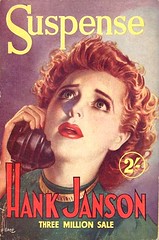Yesterday, Deb Salisbury left a comment that’s worth discussing (or “foreblogging,” as I’ve heard it):
Sigh. I foreshadow until I’m afraid of telegraphing, but my crit partners complain about not seeing the surprise coming. I’m doing something wrong. ={
Perhaps, perhaps not, Deb. I’ve been there, too. (If one critique partner pegs the killer by page 30 and another says that the surprise reveal was unfulfilling because it wasn’t foreshadowed, which one is right?) Naturally, there are detriments to foreshadowing too heavily:
(You only have to watch 15 seconds to get the message; you don’t have to actually learn the bball technique.)
I watched a movie recently where every time a “little fact” was mentioned, I could see the plot twist they thought they were “foreshadowing.” (“I don’t swim,” says one character. I called it—she was going to fall out of the boat and the lead would have to save her. Took about 30 minutes to get there.) Maybe I’ve just seen too many movies and thought about these things too much, but total predictability is definitely not our goal as writers.
Or, to go back to our basketball analogy:
So, what’s the writing equivalent of a no-look pass? I don’t think a reader has to see a surprise coming. But I think that once the surprise is sprung, readers should be able to remember (ideally) or go back and find the clues you’ve been planted along the way.
In The Plot Thickens, Noah Lukeman gives one example of setting up a surprise—specifically, a secret:
For the secret to be used for suspenseful effect, we have to know there is a secret; Norman Bates’s mother is alluded to in shadowy fragments; in Casablanca Ilsa flat out reveals there is something she cannot tell Rick; in the whodunits, we know from the long looks the staff exchange with each other that someone is not saying something. (137)
Conversely, some surprises don’t actually have to be heavily foreshadowed: if you really can’t foreshadow because none of the POV characters have enough information or interactions to come across foreshadowing, or if the surprise is a complicating incident of a level of conflict.
Again, predictability is not a virtue in most storytelling. It’s not a bad thing to surprise your readers. But it is a delicate balance with foreshadowing and betrayal. Make sure your readers have all the pieces your characters do—but beating your readers over the head with the coming surprise is a good way to ruin it.
What do you think? What’s good foreshadowing for a surprise?






 But then again, you might. Just as tension springs from conflict, suspense is created by anticipation. So the same things that fix scene tension might not fix story suspense.
But then again, you might. Just as tension springs from conflict, suspense is created by anticipation. So the same things that fix scene tension might not fix story suspense.

